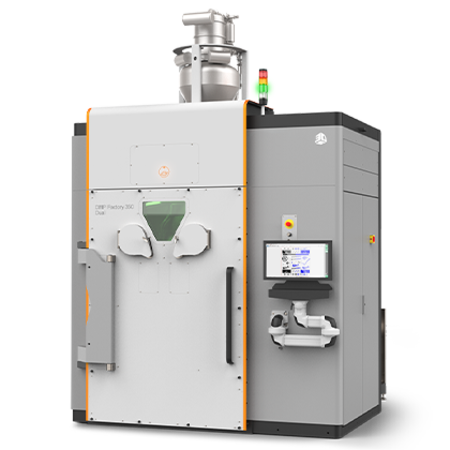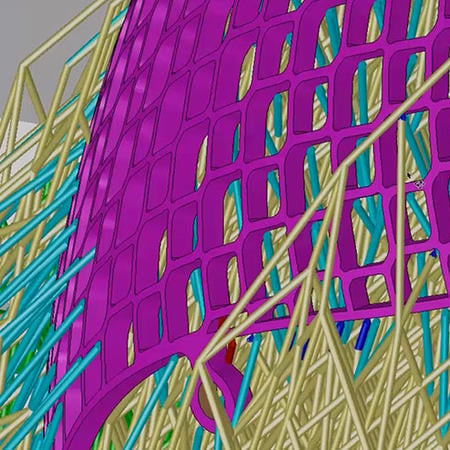A European Union (EU) Horizon 2020 project called “SMall Innovative Launcher for Europe” (also known as the SMILE Project) aims to design a small satellite launch vehicle to deliver small satellites (up to 150 kg) into a 500 km sun-synchronous orbit. The German Aerospace Center (Deutsches Zentrum für Luft- und Raumfahrt, or DLR) Institute of Structures and Design, based in Stuttgart, Germany, is one of fourteen participating organizations, and is responsible for developing a liquid/liquid rocket engine injector for the SMILE Project launcher. The Institute’s focus on a liquid propulsion system is due to the potential for system refurbishment and reuse, therefore offering a more cost-efficient solution for small satellite launchers.
"The combination of the ProX DMP 320 and 3D Systems' knowledge of design for 3D printing made it possible for us to test more design options in much less time."
- Markus Kuhn and Ilja Müller, Injector Head Project Managers, DLR
The Challenge
DEVELOP AND PRODUCE A HIGHLY COMPLEX INJECTOR HEAD FOR A LIQUID ROCKET ENGINE
In light of the high complexity of the injector head component of its liquid oxygen (LOX)/kerosene engine, DLR partnered with 3D Systems’ Customer Innovation Center (CIC) in Leuven, Belgium, to design a 3D printed injector that enables new possibilities and performance. 3D Systems’ Leuven CIC is one of four worldwide centers dedicated to accelerating advanced applications by providing customers with access to the resources necessary to develop, validate and commercialize their products.
The Solution
PARTNERING FOR SUCCESS
By opting to 3D print its coaxial injector head, DLR sought to take advantage of several key benefits of additive manufacturing, including parts count reduction with a monolithic design as well as integrating key features such as cooling channels for better performance of the overall propulsion system.
Markus Kuhn and Ilja Müller manage the injector head project at DLR, and say they selected 3D Systems as a partner given the 3D printing company’s successful track record in metal 3D printing for aerospace applications. "Based on the success of space related initiatives involving DMP, we thought that 3D Systems was perfectly suited for providing the design-for-manufacturing aspects of the injector head, with an eye on new possibilities for sensor integration and fuel and coolant distribution," says Kuhn.
01 Optimizing fuel injector design and reducing part count
The injector of a rocket is the part from which the fuel and oxidizer enter into the combustion chamber. A successful liquid rocket fuel injector expels these components in a manner that ensures they atomize and mix properly to produce the combustion required to move the rocket.
According to Koen Huybrechts, a project engineer for 3D Systems, the liquid-fueled injector head envisioned by DLR includes several performance-enhancing features that were uniquely enabled by 3D printing with DMP: "The need for optimized performance and cooling, the design complexity of the pressure and temperature sensor channels, and the desire to simplify assembly and production with consistent, easily repeatable processes all pointed to the ProX® DMP 320," says Huybrechts.
Metal 3D printing with DMP enabled DLR to:
- Optimize part performance via new opportunities for fuel and coolant distribution;
- Easy implement 3D-pathed pressure and temperature sensor channels;
- Eliminate intermediate production and assembly steps;
- Independently optimize thermal, mass and hydraulic performance without the restrictions of traditional fabrication methods;
- Avoid assembly failure points and enhance quality aspects with a monolithic design;
- Reduce machining steps to produce a highly integrated and multifunctional injector.
By using metal 3D printing, DLR was able to drastically change the design methodology of its coaxial injectors and avoid the need for multiple subcomponents, which contributed to significantly lowered production time and cost. A parts count reduction from 30 to one contributed to a final weight reduction of ten-percent and removed known points of failure at fastening sites to alleviate related quality control measures and improve system performance.
02 Consolidating parts with precision metal printing
3D Systems’ application engineers used 3DXpert™ to prepare the injector head file for printing. 3DXpert is an all-in-one software that covers the entire metal additive manufacturing process. 3D Systems performed pre-printing operations to facilitate powder removal in post-processing, as well as a printability check to ensure the part would build without complication.
The final part was printed at 3D Systems’ Leuven CIC on a 3D Systems ProX DMP 320 metal printer in LaserForm® Ni718 (A), an oxidation and corrosion-resistant Inconel alloy. LaserForm Ni718 (A) is characterized by good tensile, fatigue, creep and rupture strength at cryogenic temperatures up to 700˚C, and is therefore ideal for high temperature applications.
Once printed, 3D Systems’ team removed unused material from the part’s interior, heat-treated the part for stress relief, and removed the part from the build plate using wire Electrical Discharge Machining (EDM).
03 Tool-less production accelerates design cycle
With 3D Systems’ additive manufacturing expertise and DMP, DLR was able to quickly incorporate and explore design changes without the need for time-consuming tooling. This capability was critical to DLR’s design cycle, since it faced lead times of only a few weeks for phase one design and testing of the injector head prototype.
"The combination of the ProX DMP 320 and 3D Systems' knowledge of design for 3D printing made it possible for us to test more design options in much less time," say Kuhn and Müller.
Metal 3D printing enabled DLR to apply coaxial injection techniques with a double-swirl injector element to optimize the oxidizer-fuel mixing of the injector head. Two different cooling solutions were implemented, each using fine channels with minimum feature sizes of 0.2 mm and maximum length/diameter ratios of 45. The design also integrates a film-laying feature in the injector head, enabling engineers to adjust the film mass flow rate directly at the injector.
04 Greater performance at lower costs
DLR unlocked additional performance enhancements by directly integrating a coolant distribution system with the injector, allowing engineers to implement and independently control wall transpiration and film cooling techniques. When applied within the injector, a coolant film forms on the hot inner side of the combustion chamber that protects the wall structure from high heat fluxes. This type of system is considered much easier and cheaper to manufacture than classical regenerative cooling.
Together with sophisticated ceramic materials like ceramic fiber matrix composites (CMCs), the design and manufacturing approach developed by DLR and 3D Systems could potentially enable the structures and systems developed for the injector head to be reused multiple times and the technology transferred to other applications.
To evaluate the new design, DLR conducted numerical simulations on internal flows to estimate the fuel distributions and associated pressure losses in the feed lines for each propellant. Subsequent cold-flow tests showed a good correlation between numerically and experimentally measured data. Hot-fire testing for the final 3D printed injector head at PLD Space in Spain (another SMILE Project partner) showed good mixing and combustion efficiencies in combination with the rocket thrust chamber assembly designed by DLR.
Moving forward, the new design and manufacturing processes enabled by metal printing are expected to continue delivering a high degree of geometrical freedom, fewer production steps for faster time-to-market, optimized use of materials and parts, ongoing performance improvements, and enhanced structural integrity to extend the injector's lifespan.
"We think we can safely say that the integrated functionalities of the 3D printed injector head are superior and the production times and costs lower when compared to state-of-the-art equivalent parts manufactured via conventional methods," says Müller.
The Results
IMPROVED FINAL PART PERFORMANCE AND INCREASED PRODUCTION EFFICIENCY
METAL ADDITIVE IN AEROSPACE
Metal 3D printing has built momentum as a key technology in aeronautics and aerospace due to the alignment of its benefits with the industry's key priorities, including reduced weight, fuel savings, greater operational efficiencies, parts consolidation, accelerated time-to-market, and fewer storage requirements for parts.
Recent projects that have proven the efficacy of 3D Systems’ DMP technology in the aerospace market include:
- The first 3D printed radio frequency (RF) filter tested and validated for use in commercial telecommunications satellites. The new filter from Airbus Defence and Space reduces weight by 50-percent over previous designs.
- Titanium brackets that are 25-percent lighter and feature a better stiffness-to-weight ratio than those manufactured by traditional means, introduced through a collaboration between Thales Alenia Space and 3D Systems.
- Engine parts created in a project by the European Space Agency (ESA) and 3D Systems that save weight, simplify assembly, speed manufacturing, and enable easier late-stage design adaptation.
- A topologically optimized aircraft bracket that reduces weight by 70-percent while satisfying all functional requirements and meeting the GE Aircraft challenge.
Get in touch for more information on DMP for your application.
This work is performed within the ‘SMall Innovative Launcher for Europe’ project. SMILE, coordinated by NLR, has received funding from the European Union’s ‘Horizon 2020 research and innovation program’ under grant agreement No 687242.


